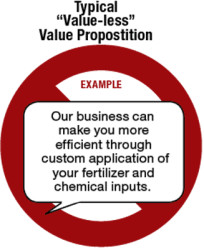The Value Proposition

Last month, I introduced the concept of customer “pain” or business problem. Pain comes in two flavors: Latent and Admitted. The following situations are examples of Latent Pain.
– The customer is not attempting to solve a problem for which you can see a solution.
– The customer is unaware a potential solution exists for his or her problem, or may have failed at previous attempts to solve the problem.
– The customer has turned on his or her rationalization filter and thinks various potential solutions are “too expensive,” “too compliÂcated,” “too risky,” etc. You have heard these false objections many times.
“Pain drives change,” so if you can’t elevate Latent Pain to Admitted Pain, there will be no sale. Next month, I’ll discuss a proven questioning technique that will help you uncover Latent Pain with customers and prospects.
The following situations are examples of Admitted Pain:
– The customer is willing to discuss his or her problems or dissatisfaction with the existing situation.
– The customer admits to a problem in his or her farming operation, but doesn’t know how to solve it.
Don’t Assume The Sale
Just because a customer or prospect will discuss his or her business issues doesn’t mean he or she will buy from you. We must advance the selling process to where the customer confirms our understanding of his or her situation, and accepts the action you and he/she collaborate on to solve the problem. To accomplish this, we need to demonstrate value early in the selling process. Creating Value Propositions is a key skill in selling your solution. Essentially, they are simple, clear statements of:
– The key quantified benefits you may offer a grower to address his potential critical business issue(s).
– The projected total investment of providing the benefits.
A Value Proposition is based on:
– Your knowledge of the specific benefit already achieved by another customer.
– Your experience with a customer with a potentially comparable situation.
– Your estimation of the value you provided to the reference customer.
Last month, I said Reference Stories and Value Propositions were the key job aides in the Create step of Solution Selling for Agriculture. A Reference Story is used early in the selling process to create credibility and encourage a customer to discuss his or her own problems. They are designed to stimulate interest, but don’t provide details on the actual solution implemented. In Solution Selling it’s necessary to understand the customer’s problem before prescribing a solution or attempting to sell a product. The diagram shows how your Reference Story of working with one customer is extrapolated to develop an initial Value Proposition for another customer or prospect. An initial Value Proposition is your estimate of what you can offer the customer based on your understanding of his business issues to this point. A Value Proposition is always fine-tuned as your understanding of the customer’s situation increases.
Because Value Propositions are so important in Solution Selling, I want to compare a “value-less” Value Proposition with an effective initial Value Proposition. First the bad (above). Note there is no compelling reason for the customer to listen to you in the value-less example. This Value-less Proposition is a trial balloon that lacks customer knowledge. It doesn’t differentiate you from competitors, and like most trial balloons, it will float away. In today’s extremely competitive retail market, you need to bring a sharp focus to every selling situation. Selling professionals in every industry are learning that a service strategy does not necessarily translate into customer value. Without understanding a customer’s unique situation, service can become a one-size-fits-all approach that is not sufficient for high-value, knowledge based selling. What is required is to bring your agronomic skill set, your company’s dedication to service, and a deep knowledge of your customers’ business issues to solving their problems.
Leading By Example
Here’s an example of a good value proposition that incorporates elements of what you have done for other customers and provides specific actions leading to dollarized benefits. Note this initial Value Proposition also identifies the investment you are looking for from the customer. The customer will likely want to know the assumptions that underlie your Value Proposition, so be prepared to back up your claims.
I have used “initial value proposition” in this column with specific intent. Value Propositions are a work in progress that require upgrading as you uncover additional customer information. In the early phase of the sales process you likely haven’t gathered all the information you need to develop a final Value Proposition. Your goal with an initial Value Proposition is to create enough interest to motivate the customer to more fully discuss their business problems and their impact with you.
This concludes my discussion of the Create step in Solution Selling for Agriculture. Next month, I’ll begin a review of the Develop step, which will introduce the questioning technique you can use to fully uncover customer issues, help the customer understand the impact of these issues on his farming operation, and then jointly develop a shared vision of a potential solution.





